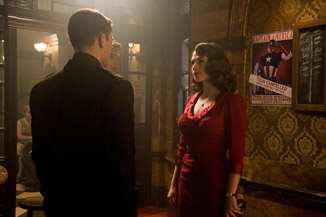|
|
(Comic) Book vs. MovieCaptain AmericaBy Russ BickerstaffJuly 28, 2011
The men sit in an observation room as an unnamed doctor administers a “strange, seething liquid” via a rather large hypodermic to a thin blond man in green pants. As the blond man begins to undergo some kind of change, the doctor tells us that the man had been turned down for military service just earlier that day due to his generally unfit condition. A serum courses through his blood that is “rapidly building his body and brain tissues,” thus increasing his stature and intelligence. The military representatives are impressed at the man’s transformation. The doctor proclaims it a success. The recently frail man is dubbed Captain America - envisioned to be the first in a corps of “super-agents,” who will become a terror to foreign spies and saboteurs. As one could probably guess, though, Nazi spies have seen the demonstration and kill the doctor immediately. As the serum is destroyed as well, it is lost forever. (Evidently he didn’t write anything down.) Captain America defeats the spies. In a single panel, we see that the hero now wears a patriotic flag-inspired costume and is actively rooting-out spies in the U.S. military. Evidently as a day job, he serves as army private Steve Rogers. The final page and a half of the story involve a kid identified as “mascot” of Rogers’ army regiment named Bucky Barnes. He comes into Rogers’ tent and sees him changing into the Captain America costume - thereafter fighting alongside him in a similar costume as the companion hero, “Bucky.” The origin story was eight pages long - it is followed in the first issue by another couple of stories typical of the golden age era of comics. Stalwart hero accompanied by teenaged sidekick fight to defend the U.S. at home from fifth columnists. There’s kind of an espionage thriller aspect to the stories - kind of a cross between Batman and James Bond dressed-up in red, white and blue. Over the course of the next ten issues, Cap and Bucky fight villains with strange appearances employing bizarre gimmicks not unlike the rogues gallery in Batman or Dick Tracy. The first issue has stories pitting Captain America against a strange psychic homunculus, a man named “the Crusher,” and, most notably the Red Skull, a Nazi spy named after the mask he wears. True to form for the period, all stories were wrapped-up quite nicely in just a few pages. (The Red Skull turns out to be an aircraft company executive who was promised a position of great authority under a Nazi-ruled U.S.)
[ View other columns by Russ Bickerstaff ]
[ View other Book vs. Movie columns ]
[ Email this column ]
|

|
|
|

|
Friday, November 1, 2024
© 2024 Box Office Prophets, a division of One Of Us, Inc.


